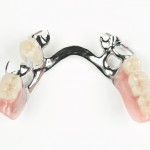
The use of removable partial dentures is a long established approach to replacement of missing teeth. With the increase in use of dental implants their use is considered by many to be a second-choice therapy. However, medical, cost or other clinical contraindication may limit implant use so rehabilitation with dental prostheses still makes up a significant portion of everyday clinical practice.
The aim of this study was to conduct a systematic literature review on the survival rates of removable dental prostheses (RDP) in the moderately reduced dentition.
Methods
Searches were conducted in the Medline, Embase, BIOSIS, SciSearch/DIMDI, Cochrane and FIZ Technik Web databases supplemented by hand searches in the journals, Clinical Oral Investigations, & The International Journal of Prosthodontics, The Journal of Prosthetic Dentistry, Deutsche Zahnärztliche Zeitschrift, Schweizer Monatsschrift für Zahnmedizin, Journal of Dentistry and Journal of Dental Research.
Two reviewers independently selected the studies for inclusion. Randomised controlled trials (RCTs), prospective and retrospective studies on survival rates of removable dental prostheses in the moderately reduced dentition with at least 15 participants, an observation period of at least 2 years, and a dropout rate of less than 25 % were considered. The primary variables recorded were the survival rates of the restorations and the abutment teeth. A narrative summary of the findings was presented owing to the heterogeneity of patient selection, study designs and measurement criteria.
Results
- 19 publications were included, 6 being reports of different observation periods.
- There were 9 RCTs, 3 prospective and 7 retrospective trials.
- Follow up periods ranged for 2-25 yrs.
- Cast-metal framework dentures exhibited failure rates of between 33 and 50 % after 5 years.
- One study with a 25-year observation period reported failure rates of 50%.
- Better results were obtained with proper pre-treatment and a good recall scheme. Bilateral attachment prostheses showed failure rates of between 11 and 30 % after 5 years.
- Unilateral attachment prostheses showed failure rates of 75 % after 5 years.
- Double-crown prostheses dentures show failure rates of 0 to 21.7% after 3 to 6years.
Conclusions
The authors concluded:-
Given the clinical significance of the topic under analysis, the range of available studies is anything but impressive. Treatment recommendations for treating the partially edentulous arch with removable restorations are not possible at the highest level of evidence. It would be desirable to have access to studies with a standardized and flawless methodology.
Comments
Despite an extensive search strategy and including retrospective studies the authors were only able to include a small number of studies addressing this question. All the included studies were conducted in a university or hospital environment and the heterogeneity of the studies and evaluation criteria made comparisons difficult so a narrative summary of the findings was presented. As the reviewers note there is a clear need for common outcome assessment criteria and high quality conduct and reporting of studies in this area.
Links
Primary paper
Moldovan O, Rudolph H, Luthardt RG. Clinical performance of removable dental prostheses in the moderately reduced dentition: a systematic literature review. Clin Oral Investig. 2016 Jun 9. [Epub ahead of print]Review. PubMed PMID: 27283325.
Other references
Dental Elf 29th Sep 2015
Partial dentures provided partial compensation for masticatory function
Dental Elf 13th Aug 2015

[…] post Removable dental prostheses: Limited evidence on clinical performance appeared first on […]
Removable dental prostheses: Evidence on clinical performance limited https://t.co/x384oVZWPH
Little evidence available of the clinical performance of removable dental prostheses https://t.co/x384oVZWPH
Evidence on the clinical performance of removable dental prostheses is limited https://t.co/x384oVZWPH
Few high quality studies on the clinical performance of removable dental prostheses https://t.co/x384oVZWPH
Don’t miss – Removable dental prostheses: Limited evidence on clinical performance https://t.co/x384oVZWPH